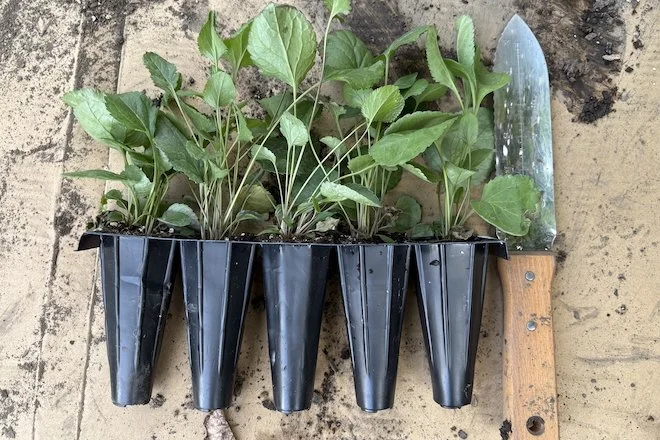This week: Advantages of Planting Plugs
Hello!
This week, I planted 45 native plants in a little over an hour using only a garden knife. How was this incredible feat accomplished? I was planting landscape plugs. Landscape plugs are small first-year plants (usually) that are sold in flats of 32 to 70. Plugs range from 2.5 inches deep to 5 inches deep (mine were 4 inch). They are mostly sold to nurseries or professional landscape installers, although DIYers can purchase them from a few online sources, such as Izel Plants.

There are two major advantages to plugs: price and ease of planting. They usually cost $3 to $5 per plant, but the downside is that you buy them by the flat—the discount is in the small plant size and big quantity. So, plugs are suitable for large sites, groundcovers, or dividing among friends.
Plugs are also incredibly easy to plant. You can use a garden knife or trowel to make a pocket and drop the plant in. Tool collectors can use an auger. It’s quick work, even on slopes, among tree roots, or in rocky or clay soils, as you don’t need to dig a very big hole.
You’ve probably bought plugs before and didn’t even realize it. They are commonly found in kits (like those sold by Prairie Moon Nursery), at fundraising plant sales (mine were from a Penn State Extension sale), and they are also often “potted up” and resold by nurseries. If a native plant nursery doesn’t specify that they grow their plants from seed, and the plant is young, they are probably buying plugs, planting them in a slightly bigger pot, and reselling them to you so you can buy five plants instead of fifty. A handy service!
Elsewhere:
Penn State Extension is offering a free webinar on October 15 at 1:00 pm about native seed collecting and planting, both for wildflowers and trees and shrubs. No need to be a Pennsylvania resident to join!
Have a great week,
Julie